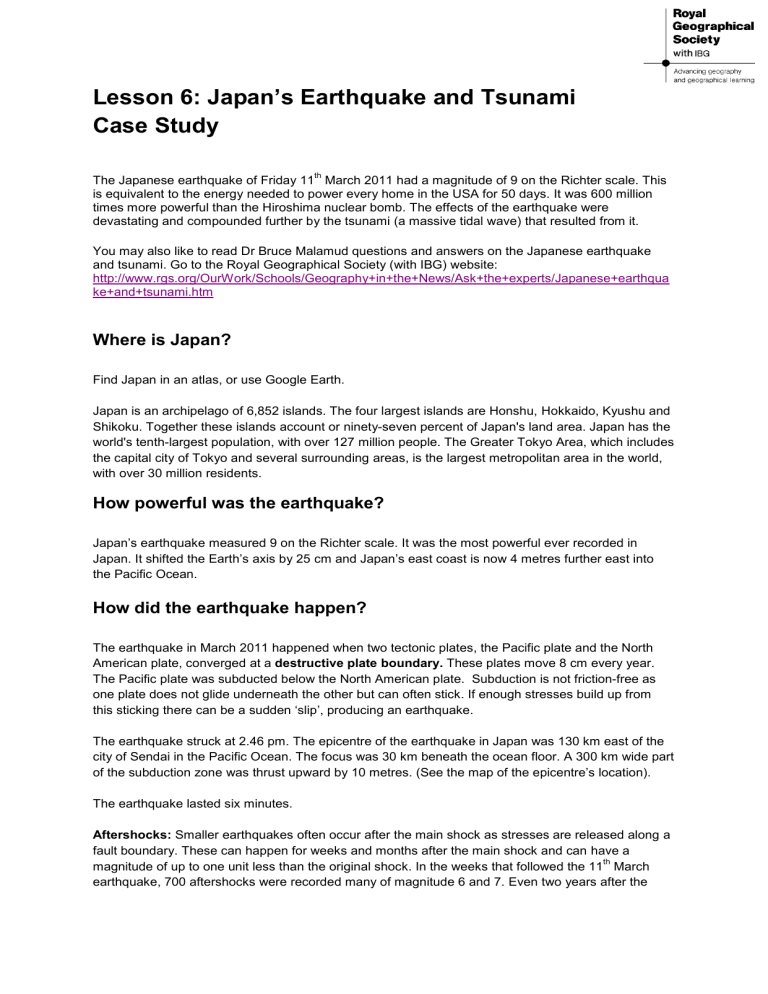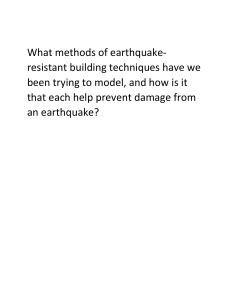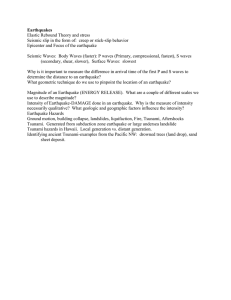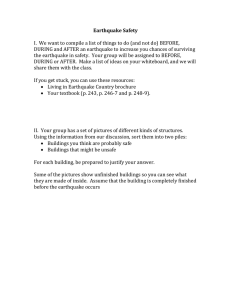Japan Earthquake & Tsunami Case Study: Causes & Impact
advertisement

Lesson 6: Japan’s Earthquake and Tsunami Case Study th The Japanese earthquake of Friday 11 March 2011 had a magnitude of 9 on the Richter scale. This is equivalent to the energy needed to power every home in the USA for 50 days. It was 600 million times more powerful than the Hiroshima nuclear bomb. The effects of the earthquake were devastating and compounded further by the tsunami (a massive tidal wave) that resulted from it. You may also like to read Dr Bruce Malamud questions and answers on the Japanese earthquake and tsunami. Go to the Royal Geographical Society (with IBG) website: http://www.rgs.org/OurWork/Schools/Geography+in+the+News/Ask+the+experts/Japanese+earthqua ke+and+tsunami.htm Where is Japan? Find Japan in an atlas, or use Google Earth. Japan is an archipelago of 6,852 islands. The four largest islands are Honshu, Hokkaido, Kyushu and Shikoku. Together these islands account or ninety-seven percent of Japan's land area. Japan has the world's tenth-largest population, with over 127 million people. The Greater Tokyo Area, which includes the capital city of Tokyo and several surrounding areas, is the largest metropolitan area in the world, with over 30 million residents. How powerful was the earthquake? Japan’s earthquake measured 9 on the Richter scale. It was the most powerful ever recorded in Japan. It shifted the Earth’s axis by 25 cm and Japan’s east coast is now 4 metres further east into the Pacific Ocean. How did the earthquake happen? The earthquake in March 2011 happened when two tectonic plates, the Pacific plate and the North American plate, converged at a destructive plate boundary. These plates move 8 cm every year. The Pacific plate was subducted below the North American plate. Subduction is not friction-free as one plate does not glide underneath the other but can often stick. If enough stresses build up from this sticking there can be a sudden ‘slip’, producing an earthquake. The earthquake struck at 2.46 pm. The epicentre of the earthquake in Japan was 130 km east of the city of Sendai in the Pacific Ocean. The focus was 30 km beneath the ocean floor. A 300 km wide part of the subduction zone was thrust upward by 10 metres. (See the map of the epicentre’s location). The earthquake lasted six minutes. Aftershocks: Smaller earthquakes often occur after the main shock as stresses are released along a fault boundary. These can happen for weeks and months after the main shock and can have a th magnitude of up to one unit less than the original shock. In the weeks that followed the 11 March earthquake, 700 aftershocks were recorded many of magnitude 6 and 7. Even two years after the original shock, an aftershock of a magnitude 7 was recorded originating from the same section of the plate boundary. How did the tsunami happen? The 2011 earthquake occurred because a section of the Earth’s crust, 300 km long, moved upwards 10 metres. This meant that some of the ocean floor was suddenly uplifted causing an unexpected and enormous jolt to the water at the bottom of the ocean. Some waves were sent towards Japan’s coastline and another set of waves travelled farther out into deeper water in the Pacific. Tsunamis waves are not very high in the deep ocean but they travel exceptionally fast. They can reach speeds of around 800 km per hour, which is as fast as a jet-liner. As the waves approach land and enter shallower water, however, they slow down and become increasingly higher. The tsunami that resulted from the 2011 earthquake was composed of 10 waves, 1 km apart and in places 15 metres high. Although 40% of Japan’s coastline has 10 metre high protective coastal walls, the waves just went over the top. The first wave hit Japan 24 minutes after the earthquake. The last wave hit Japan 3 ½ hours after the earthquake. The tsunami travelled as far as 10km inland. The earthquake triggered tsunami warnings throughout the Pacific. It generated waves 3 to 4 metres high along the coast of Hawaii, 3 metres high along the coast of California and finally 18 hours after the earthquake was first felt in Japan, waves 30cm high even reached the coast of Antarctica. The Impact Loss of life: The loss of life was extensive. 16,000 people are known to have died, 6 000 people were injured and 3 000 people are still listed as missing. Millions of people lost their homes and livelihoods. One year after the earthquake more than 300,000 people were still living in temporary accommodation. Buildings and infrastructure: 300,000 buildings were completely destroyed and a further 1 million were damaged. 4000 roads, 78 bridges and 29 railways were also damaged. Observers at the time described scenes of complete and utter devastation. This resulted in an estimated 25 million tonnes of debris- much of which is still awaiting disposal. The reconstruction of the devastated areas is expected to cost £181 billion (23 trillion yen) in total. Fukushima Nuclear Power Plant: At the time of the earthquake millions of people were affected by power cuts and other shortages. The threat of radiation poisoning was also apparent. The Fukushima Nuclear Power Plant was badly damaged in the disaster. Three of its reactors suffered melt down. At the time, radiation in excess of government standards was found milk and spinach from the area, as well as tap water in Tokyo, 150 miles away. The health ministry also advised people up to 19 miles away from the power plant, not to drink tap water after tests revealed it contained abnormal, though not harmful, amounts of iodine-131. Today, the danger from Fukushima is still not contained. Currently under construction is a 1500 metre frozen barrier, costing £185 million. The aim is to stop highly toxic radioactive water (used to cool the O reactors) from sinking into the clean groundwater. Pipes containing a coolant (at minus 30 C) will be sunk into the ground surrounding the damaged reactors to freeze it into a solid barrier. The barrier is expected to be completed by March 2015. Limiting earthquake damage in Japan: Japan is well known for being particularly susceptible to earthquakes as it is located at the meeting place of four tectonic plates. There are several measures taken in Japan to limit potential earthquake damage: Emergency drills: from a young age children are taught when and how to take cover. People are encouraged to keep emergency rations in their homes. Building codes ensure modern buildings are built to sway and withstand shocks. A warning often goes out after NY initial body waves are detected (seismic waves deep underground). When the warning is sounded, people take cover. Escalators are stopped, trains are stopped and gas mains are shut off. After this warning there may be as much as one minute before the more destructive surface waves arrive. Video clips There are many eye-witness video clips available that show the effects of the 2011 earthquake and tsunami. These are freely available on You-Tube and make for powerful viewing. However, you will need to watch them carefully first as they, perhaps understandably, can contain inappropriate language. It might also be worth looking also at the following links: Go to the Telegraph website: http://www.telegraph.co.uk/news/worldnews/asia/japan/8376492/Japanese-earthquake-and-tsunamiin-video.html Go to the National Geographic website: http://video.nationalgeographic.com/video/news/japantsunami-2011-vin Additional pupil activity Pupils could complete a storyboard, explaining the formation of earthquakes and tsunamis in relation to the 2011 earthquake in Japan. The storyboard should time-sequence the events.







